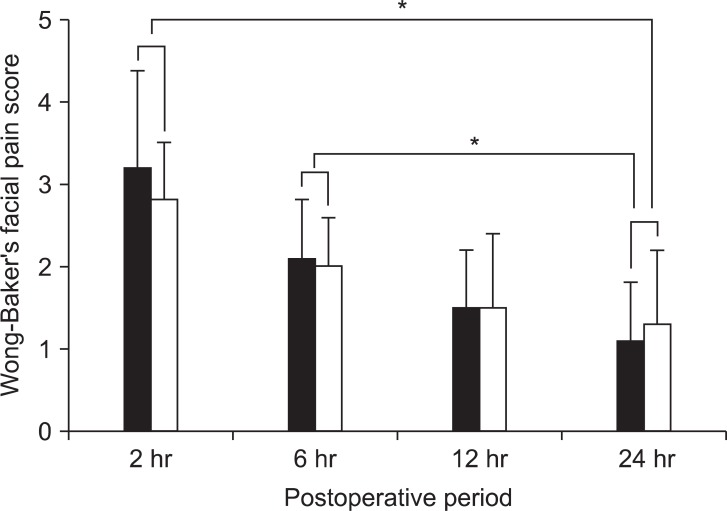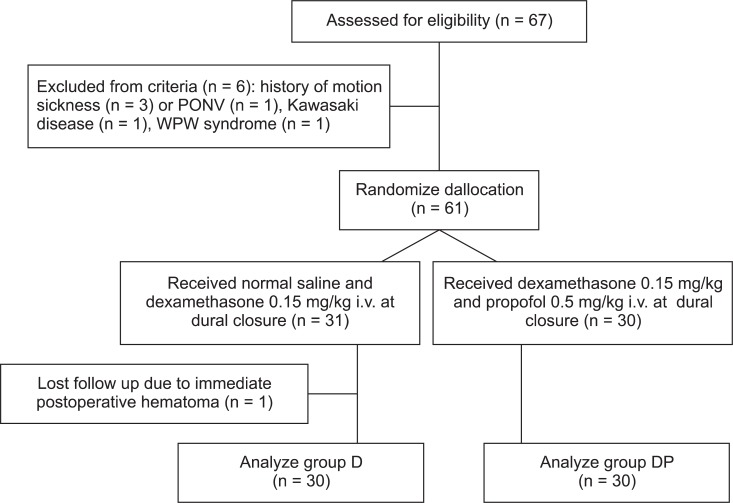1. Hayashi T, Shirane R, Fujimura M, Tominaga T. Postoperative neurological deterioration in pediatric moyamoya disease: watershed shift and hyperperfusion. J Neurosurg Pediatr. 2010; 6:73–81. PMID:
20593991.

2. Kansha M, Irita K, Takahashi S, Matsushima T. Anesthetic management of children with moyamoya disease. Clin Neurol Neurosurg. 1997; 99(Suppl 2):S110–S113. PMID:
9409418.

3. Parray T, Martin TW, Siddiqui S. Moyamoya disease: a review of the disease and anesthetic management. J Neurosurg Anesthesiol. 2011; 23:100–109. PMID:
20924291.
4. Choi SH, Lee WK, Lee SJ, Bai SJ, Lee SH, Park BY, et al. Parentcontrolled analgesia in children undergoing cleft palate repair. J Korean Med Sci. 2008; 23:122–125. PMID:
18303211.

5. Apfel CC, Kranke P, Katz MH, Goepfert C, Papenfuss T, Rauch S, et al. Volatile anaesthetics may be the main cause of early but not delayed postoperative vomiting: a randomized controlled trial of factorial design. Br J Anaesth. 2002; 88:659–668. PMID:
12067003.
6. Sakellaris G, Georgogianaki P, Astyrakaki E, Michalakis M, Dede O, Alegakis A, et al. Prevention of post-operative nausea and vomiting in children--a prospective randomized double-blind study. Acta Paediatr. 2008; 97:801–804. PMID:
18460109.
7. Apfel CC, Kranke P, Piper S, Rusch D, Kerger H, Steinfath M, et al. Nausea and vomiting in the postoperative phase. Expert- and evidence-based recommendations for prophylaxis and therapy. Anaesthesist. 2007; 56:1170–1180. PMID:
17726590.
8. Apfel CC, Korttila K, Abdalla M, Kerger H, Turan A, Vedder I, et al. A factorial trial of six interventions for the prevention of postoperative nausea and vomiting. N Engl J Med. 2004; 350:2441–2451. PMID:
15190136.

9. Subramaniam K, Pandia MP, Dash M, Dash HH, Bithal PK, Bhatia A, et al. Scheduled prophylactic ondansetron administration did not improve its antiemetic efficacy after intracranial tumour resection surgery in children. Eur J Anaesthesiol. 2007; 24:615–619. PMID:
17261211.

10. Neufeld SM, Newburn-Cook CV. The efficacy of 5-HT3 receptor antagonists for the prevention of postoperative nausea and vomiting after craniotomy: a meta-analysis. J Neurosurg Anesthesiol. 2007; 19:10–17. PMID:
17198095.

11. Furst SR, Sullivan LJ, Soriano SG, McDermott JS, Adelson PD, Rockoff MA. Effects of ondansetron on emesis in the first 24 hours after craniotomy in children. Anesth Analg. 1996; 83:325–328. PMID:
8694313.

12. Shinn HK, Lee MH, Moon SY, Hwang SI, Lee CS, Lim HK, et al. Post-operative nausea and vomiting after gynecologic laparoscopic surgery: comparison between propofol and sevoflurane. Korean J Anesthesiol. 2011; 60:36–40. PMID:
21359079.

13. Borgeat A, Wilder-Smith OH, Saiah M, Rifat K. Subhypnotic doses of propofol possess direct antiemetic properties. Anesth Analg. 1992; 74:539–541. PMID:
1554120.

14. Gan TJ, El-Molem H, Ray J, Glass PS. Patient-controlled antiemesis: a randomized, double-blind comparison of two doses of propofol versus placebo. Anesthesiology. 1999; 90:1564–1570. PMID:
10360853.
15. Song D, Whitten CW, White PF, Yu SY, Zarate E. Antiemetic activity of propofol after sevoflurane and desflurane anesthesia for outpatient laparoscopic cholecystectomy. Anesthesiology. 1998; 89:838–843. PMID:
9778000.

16. Borgeat A, Wilder-Smith O, Forni M, Suter PM. Adjuvant propofol enables better control of nausea and emesis secondary to chemotherapy for breast cancer. Can J Anaesth. 1994; 41:1117–1119. PMID:
7828261.
17. Arslan M, Demir ME. Prevention of postoperative nausea and vomiting with a small dose of propofol combined with dexamethasone 4 mg or dexamethasone 8 mg in patients undergoing middle ear surgery: a prospective, randomized, double-blind study. Bratisl Lek Listy. 2011; 112:332–336. PMID:
21692408.
18. Erdem AF, Yoruk O, Alici HA, Cesur M, Atalay C, Altas E, et al. Subhypnotic propofol infusion plus dexamethasone is more effective than dexamethasone alone for the prevention of vomiting in children after tonsillectomy. Paediatr Anaesth. 2008; 18:878–883. PMID:
18768048.

19. Wong DL, Baker CM. Pain in children: comparison of assessment scales. Pediatr Nurs. 1988; 14:9–17. PMID:
3344163.
20. Kovac AL. Management of postoperative nausea and vomiting in children. Paediatr Drugs. 2007; 9:47–69. PMID:
17291136.

21. Roberts GW, Bekker TB, Carlsen HH, Moffatt CH, Slattery PJ, McClure AF. Postoperative nausea and vomiting are strongly influenced by postoperative opioid use in a dose-related manner. Anesth Analg. 2005; 101:1343–1348. PMID:
16243992.

22. White PF. The changing role of non-opioid analgesic techniques in the management of postoperative pain. Anesth Analg. 2005; 101(5 Suppl):S5–S22. PMID:
16334489.

23. Ahn HJ, Kim JA, Lee JJ, Kim HS, Shin HJ, Chung IS, et al. Effect of preoperative skull block on pediatric moyamoya disease. J Neurosurg Pediatr. 2008; 2:37–41. PMID:
18590393.

24. Gan TJ, Glass PS, Howell ST, Canada AT, Grant AP, Ginsberg B. Determination of plasma concentrations of propofol associated with 50% reduction in postoperative nausea. Anesthesiology. 1997; 87:779–784. PMID:
9357878.

25. Lejus C, Tissot M, Roquilly A, Populaire C, Guillaud C, De Windt A, et al. Risk factors of postoperative vomiting in children receiving continuous intravenous morphine. Minerva Anestesiol. 2012; 78:160–167. PMID:
21750486.





 PDF
PDF Citation
Citation Print
Print





 XML Download
XML Download